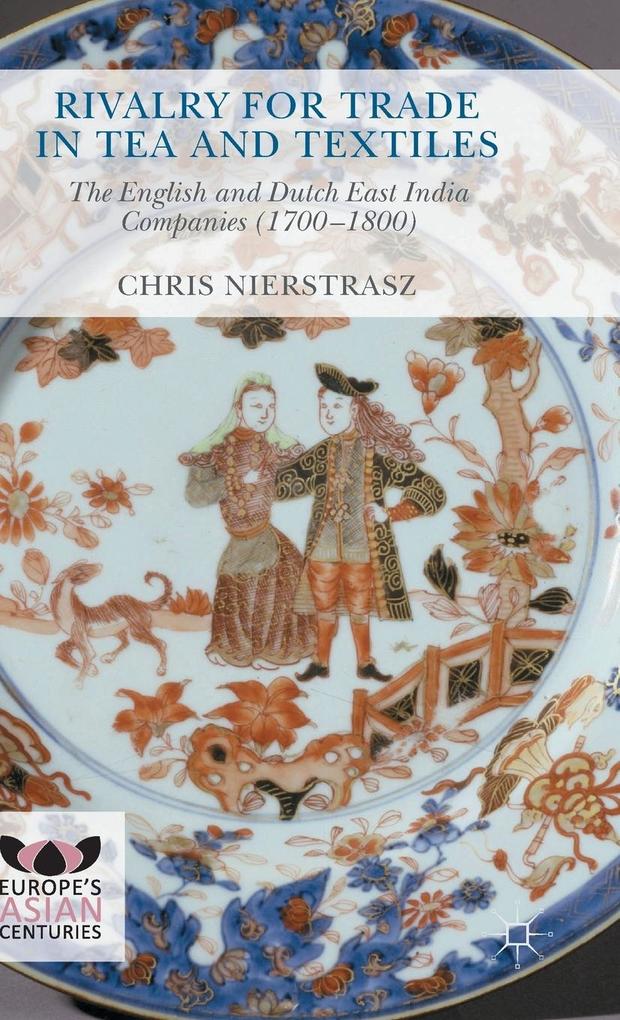
Zustellung: Mi, 04.06. - Sa, 07.06.
Versand in 1-2 Wochen
VersandkostenfreiBestellen & in Filiale abholen:
The rivalry for trade in tea and textiles between the English and Dutch East India companies is very much a global history. This trade is strongly connected to emblematic events such as the opening of Western trade with China, the Boston Tea Party, the establishment of British Empire in Bengal and the Industrial Revolution.
Inhaltsverzeichnis
PART I: IMPERFECT MONOPOLIES
1. Imperfect monopoly in trade
1.1 Mix of commodities
1.2 Monopoly and private trade
2. Imperfect monopoly in Europe
2.1 Silver and taxation
2.2 Re-export of Asian commodities
3. Imperfect monopoly in Asia
3.1 Beyond Silver
3.2 Intra-Asian trade and Empire
3.3 Empire and the home-state
Conclusion
PART II: RIVALRY FOR TEA: EMPIRES AND PRIVATE TRADE
1. Tea and monopoly
1.1 Competition for monopoly (1685-1730)
1.2 A Competitive Market (1730-1790)
2. Empires and Tea
2.1 Direct trade and empire
2.2 EIC intra-Asian trade and English country trade
2.3 British Empire and Canton
3. Private trade and tea
3.1 The 'Discovery' of Tea
3.2 Private Trade and Batavia
3.3 Private trade in tea as a tool of competition
3.4 English Private Trade in Tea
Conclusion
PART III: POPULARISATION OF TEA: SMUGGLERS AND DIFFERENT VARIETIES OF TEA
1. Smuggling and Britain
1.1 The problem of contraband tea
1.2 An answer to smuggling
2. Smuggling and America
2.1 Unnoticed smuggling
2.2 British Empires connect
3. Selections of tea
3.1 Different varieties, different prices
3.2 A different selection of tea
Conclusion
PART IV RIVALRY FOR TEXTILES: A GLOBAL MARKET
1. Europe and India
1.1 Imports of Indian Textiles
1.2 Textiles and Mercantilism
2. Textiles and Empire in Asia
2.1 Intra-Asian trade and textiles
2.2 Balancing Asia and Europe
2.3 English dominance
Conclusion
PART V: THE CONSUMPTION OF TEXTILES: RETURN CARGOES AND VARIETY
1. Different regions, different textiles
2. Competition for textiles
2.1 Muslins
2.2 White Calicoes
2.3 Coloured Calicoes
3. Imports of Indian textiles and the Industrial Revolution
Conclusion
1. Imperfect monopoly in trade
1.1 Mix of commodities
1.2 Monopoly and private trade
2. Imperfect monopoly in Europe
2.1 Silver and taxation
2.2 Re-export of Asian commodities
3. Imperfect monopoly in Asia
3.1 Beyond Silver
3.2 Intra-Asian trade and Empire
3.3 Empire and the home-state
Conclusion
PART II: RIVALRY FOR TEA: EMPIRES AND PRIVATE TRADE
1. Tea and monopoly
1.1 Competition for monopoly (1685-1730)
1.2 A Competitive Market (1730-1790)
2. Empires and Tea
2.1 Direct trade and empire
2.2 EIC intra-Asian trade and English country trade
2.3 British Empire and Canton
3. Private trade and tea
3.1 The 'Discovery' of Tea
3.2 Private Trade and Batavia
3.3 Private trade in tea as a tool of competition
3.4 English Private Trade in Tea
Conclusion
PART III: POPULARISATION OF TEA: SMUGGLERS AND DIFFERENT VARIETIES OF TEA
1. Smuggling and Britain
1.1 The problem of contraband tea
1.2 An answer to smuggling
2. Smuggling and America
2.1 Unnoticed smuggling
2.2 British Empires connect
3. Selections of tea
3.1 Different varieties, different prices
3.2 A different selection of tea
Conclusion
PART IV RIVALRY FOR TEXTILES: A GLOBAL MARKET
1. Europe and India
1.1 Imports of Indian Textiles
1.2 Textiles and Mercantilism
2. Textiles and Empire in Asia
2.1 Intra-Asian trade and textiles
2.2 Balancing Asia and Europe
2.3 English dominance
Conclusion
PART V: THE CONSUMPTION OF TEXTILES: RETURN CARGOES AND VARIETY
1. Different regions, different textiles
2. Competition for textiles
2.1 Muslins
2.2 White Calicoes
2.3 Coloured Calicoes
3. Imports of Indian textiles and the Industrial Revolution
Conclusion
Produktdetails
Erscheinungsdatum
21. September 2015
Sprache
englisch
Auflage
1st ed. 2015
Seitenanzahl
226
Reihe
Europe's Asian Centuries
Autor/Autorin
Chris Nierstrasz
Verlag/Hersteller
Produktart
gebunden
Abbildungen
XVI, 226 p. 25 illus.
Gewicht
454 g
Größe (L/B/H)
218/140/20 mm
ISBN
9781137486523
Entdecken Sie mehr
Pressestimmen
It does adopt important and influential ideas from historians of consumption to explore the growing demand for items such as tea and textiles in eighteenth-century Europe. Ultimately, the narrative power and the interpretative possibilities offered by the single, individual company are strong and will always remain attractive to scholars, students and general readers. Rivalry for Trade in Tea and Textiles reminds us of the importance of the cornucopia of commodities imported by Europe s East India companies. (John McAleer, International Journal of Maritime History, Vol. 28 (3), August, 2016)
Bewertungen
0 Bewertungen
Es wurden noch keine Bewertungen abgegeben. Schreiben Sie die erste Bewertung zu "Rivalry for Trade in Tea and Textiles" und helfen Sie damit anderen bei der Kaufentscheidung.










